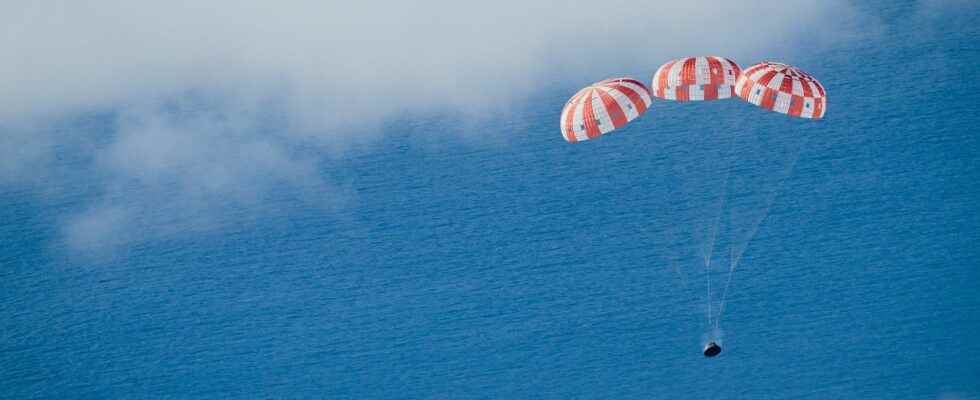As expected, NASA’s habitable vehicle successfully completed its lunar mission Artemis I by landing at 6:40 p.m. (Paris) on December 11, in the Pacific Ocean. An uneventful return that gives the green light for the following missions, planned to take astronauts around and to the Moon.
The European service module also received congratulations from the jury.
Orion home phone
After its last lunar flyby to return to Earth on December 5, only the complex landing phase remained for the Orion capsule to successfully complete its lunar mission. The maneuvers were generally more precise than expected, so the transit phase was very calm, with a few ignitions of the auxiliary engines to refine the trajectory towards the site dedicated to the return to Earth.
NASA had several options to choose from (all in the Pacific) and preferred a site not far from Guadalupe Island (Baja Peninsula), near Mexican waters and off San Diego. The weather there was perfect, with a small swell of one meter, very little wind and clouds. The Orion capsule, which for its part continued to accelerate as it “falled” towards Earth, almost reached 40,000 km/h before crossing the atmosphere.
Goodbye ESM, and thank you
One of the last important maneuvers before the encounter with Earth was to jettison the European Service Module (ESM) after its successful 25-day mission. A certain twinge in the heart for the European teams in Darmstadt, but also a source of pride for the significant participation in a long-term manned lunar project. NASA officials have repeatedly praised the work done for this module, which provides Orion with its electricity, the capsule’s air, its propulsion, its antennas and its thermal regulation!
After ejection (about an hour before crossing the atmosphere), the ESM drifted away before disintegrating over the Pacific. Orion, on the other hand, managed a deceleration in two stages, with a small rebound (skip reentry) to make the most of the braking offered by the densest layers of air. In the last phase of the flight, at less than 5 km altitude, Orion was able to eject its two extraction and braking parachutes, before deploying its three main parachutes. It landed in the water, just like in many NASA exercises and simulations over the past decade.
Return to calm before Artemis II
Currently within the USS Portland (ship dedicated to amphibious operations of the US Navy) returning to San Diego, the Orion capsule has been inspected for the first time and everything seems to be in order. It will be transported by truck to the Kennedy Space Center in the coming days, before being opened and inspected in detail by the teams on site.
The initial process will take 6 weeks, then the various components that are intended to be reused (in particular the flight control computers) will be dismantled and tested before being installed in the Orion capsule dedicated to the Artemis II mission. Like its eldest, which served in 2014 on the EFT-1 demonstration mission, the Artemis I capsule will be transformed in the coming months to undergo a new battery of tests in 2023, after which it will be retired!
NASA is planning a very busy year ahead, with the announcement of the next lunar crew in the coming months, before transferring the elements of the next copy of the Space Launch System to Florida and starting assembly. Lift-off with the astronauts of the Artemis II mission is scheduled for the second half of 2024. With the spectacular success of Artemis I, all the lights are green: manned lunar missions are back.
Source : Nasaspaceflight

11